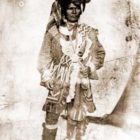Abihka Creek Indian Village
Abihka
Abihka Location Map
Abihka, Creek Indian Village History
The Abihka were the remnants of the 16th century “Chiefdom of Coosa.” A remnant of the Natchez people settled with the Abihka after being dispersed by the French in the 18th century.
Abihka was one of the four mother towns of the Muscogee Creek confederacy. It is now a ceremonial ground in Okmulgee County, Oklahoma. Abihka is also sometimes used to refer to all Upper Creek (or Muscogee) peoples.
Abihka was an Upper Creek Indian town east of the Coosa River and south of Tallassehatchee Creek. The first record of the town is found on Delisle’s map of 1704, where they are “les Abelkas,” and are noted on the east side of the Coosa River, apparently just above the influx of the Pakan Talahassi.— Winsor.
Abihka, Creek Indian Village Location
 Belen’s map of 1733, also places the “Abeccas” on the east side of the Coosa, but at some distance from it.
Belen’s map of 1733, also places the “Abeccas” on the east side of the Coosa, but at some distance from it.
The members of the Abihka were Upper Creek Indians. Their main place of residence was along the banks of the Coosa and Alabama rivers, in what is now Talladega County, Alabama, on the S. 1/2 of the S. 1/2 of sec. 17, T. 20, R. 5 E. of the Huntsville meridian.
Besides the town of Abihka, the Creek had established other important towns in their territory: Abihkutchi, Tuckabutche, Talladega, Coweta, and Kan-tcati.
The following is Benjamin Hawkins‘s description of the Abihka town as it appeared in 1799:
Au-be-coo-che, is on Nau-chee creek, five miles from the river, on the right bank of the creek, on a flat one mile wide. The growth is hard-shelled hickory. The towTi spreads itself out and is scattered on both sides of the creek, in the neighborhood of very high hUls, which descend back into waving, rich land, fine for wheat or com; the bottoms all rich; the neighborhood abounds in limestone, and large limestone eprings; they have one above, and one below the town; the timber on the rich lands is oak, hickory, walnut, poplar, and midbeny.
There is a very large cave north of the town, the entrance of which is small, on the side of a hill. It is much divided, and some of the rooms appear as the work of art; the doors regular; in several parts of the cave saltpetre is to ])e seen in crystals. On We-wo-cau creek there is a fine mill seat; the water is contracted by two hills; the fail twenty feet; and the land in the neighborhood very rich; cane is found on the creeks, and reed grows well on these lands.
This town is one of the oldest in the nation; and sometimes, among the oldest chiefs, it gives name to the nation Au-be-cuh. Here some of the oldest customs had their origin. The law against adultery was passed here, and that to regulate marriages. To constitute legal marriage a man must build a house, make his crop and gather it in; then make his hunt and bring home the meat; putting all this in the possession of his wife ends the ceremony and they are married, or, as the Indians express it, the woman is bound, and not till then. This infoiTnation is obtained from Co-tau-lau (Tus-se-ki-ah Mic-co of Coosau), an old and respectable chief, descended from Nau-che. He lives near We-o-coof-ke, has acciunulated a handsome property, o^vns a fine stock, is a man of much information, and of great influence among the Indians of the towns in the neighborhood of this.
They have no fences, and but a few hogs, horses, and cattle; they are attentive to white people who live among them, and particularly so to white women.
The Abihka took practically no part in the Creek uprising of 1813.
After their removal to Oklahoma they established their first square
ground a few miles from Eufaula. Later many of them moved far-
ther west, following the game, and they established another square,
sometimes called “Abihka-in-the-west.” Both of these have been
long abandoned.Before they left the old country two branch towns had arisen —
Talladega [Taladigi] and Kan-tcati [Kan tcatil (Red ground). They
were perhaps late in forming, sinee they do not appear separately
listed before the census of 1832.’ There is a place called ‘Conchar-
dee” a few miles north\vest of Talladega, in the county of the same
name, Alabama. After their removal the Kan-tcati busk ground
was soon given u|), hut that of Talladega has persisted dowii to the
present (hiy (1912).Gatschet enumerates two other .Vhihka towns, Teahki lako or Big
Shoal and Kayomalgi.- The former was on Choccolocco (“Big
Shoal”) Creek in Calhoun or Talladega County, Ala., and is to be
distinguished carefully from the Okfuskee town so called.” There
is some reason for thinking that Kayomalgi may have been settled
by Shawnee,’ though in 1772 a Chickasaw settlement was made on
the creek which bore this name.”^ ”The Lun-luim-ga Town in the
Abecas” is mentioned by Tobias Fitch in 1725.”On the Lamhatty map is a town called ”Apeicah,” located
apparently on the east bank of the lower Chattahoochee.” This
may perhaps be intended for Abihka, but if so it is badly misplaced.
We have no knowledge of any portion of the Abihka peoj^le living
so far to the south and east.
